Æthelberht's and Alfred's Two Skulls1
Lisi Oliver
Louisiana State University
© 2010 by Lisi Oliver. All rights reserved. This edition copyright © 2010 by The Heroic Age. All rights reserved.
Abstract: This paper argues that the unique term hion in Æthelberht §36 should be interpreted as tabulum of the skull, connecting it to the use of heafod-ban in Alfred §40.
§1. One of the many difficulties in explicating the Anglo-Saxon laws lies in the interpretation of hapax legomena for which the context gives no clear signposts to clarify the meaning. Following what I now believe to have been a misanalysis in The Beginnings of English Law (Oliver 2002, 101–2), I wish to re-examine a term contained in Æthelberht §36:2
36. Gif sio uterre hion gebrocen weorðeþ, X scillingum gebete. [36]
36.1. Gif butu sien, XX scillingum gebete. [37]
A strictly literal translation reads:
If the outer hion becomes broken, let him pay with ten shillings.
If both should be [broken], let him pay with twenty shillings.
The following discussion addresses previous interpretations of this clause and presents a new reading. The methodology of this investigation demonstrates the importance of moving beyond medieval sources, both legal and anthropological, to include modern anatomical and comparative anthropological evidence in arriving at our understanding of early medieval personal injury tariffs.
Previous Analyses of hion
§2. Benjamin Thorpe, the nineteenth-century translator of the laws of Æthelberht, follows the then common strategy of leaving the Old English word untranslated (Thorpe 1840, 5; Thatcher 1907, 213). This approach is unsatisfactory, as it avoids two crucial questions: first, what is a hion and second, what are its two (inner and outer) parts?
§3. On the basis of comparison with other Germanic laws, which generally begin the enumeration of personal injury tariffs with a clause addressing injury to the head, Felix Liebermann in Gesetze der Angelsachsen compares hion to Modern German Hirn (brain) (Liebermann 1903–16, III.10). Thorpe rightly points out the discrepancy that whereas the Modern German form is neuter, the article sio indicates that Æthelberht's hion is feminine (Thorpe 1840, 5).3 Neuter is the predominate gender for Germanic cognates; although Old Norse hjarni is masculine, I do not know of any related feminine terms. Furthermore, the Modern German term means brain; Hirnschädel is the term for skull, similar to ON hjarn-skál.
§4. Addressing the latter argument first: it would be hardly be surprising that a single term could encompass both the meanings "brain" and "skull": see, for example, Latin cerebrum. C. D. Buck points out that "most of the words [inherited from Proto-Indo-European] for 'brain' are cognate with words for 'head' or 'marrow'" (Buck 1949, 215).
§5. Overwhelmingly, early medieval personal injury tariffs contain, and generally begin with, a term for "head" or "skull": Salic, Ripuarian, Alamann, Frisian, Bavarian and Lombard all use Latin caput (head); Chamavan uses Latin curtem (pot), and Visigoth uses the hapax cassos, which may well be scribal error for either cassus (hollow) or—more likely, in my opinion—cassis (helmet).4 (Cross-linguistically the terms for "head" and "pot" are often related: medical Latin uses the term testa for "brainpan"; variant meanings are "earthenware pot" and, somewhat unsettlingly, "potshard"—this is the source of modern Romance terms including French tête and Italian testa.) The earliest Norse laws to contain injury tariffs—the Gulathingslov and the Frostathingslov—both use hofði, and early Irish and Welsh laws use the cognate terms cenn and pen respectively. Æthelberht's personal injury schedule would be a rarity if it did not begin with a regulation concerning the head or skull.
§6. Following Æthelberht, the next laws in the Anglo-Saxon territories to contain personal injury tariffs are those promulgated in the late ninth century by Alfred the Great, in which the section on wounds begins:
40. Heafodwund to bote, gif ða ban butu beoð ðyrele, gesylle XXX scll' him mon.
41. Gif þæt utre ban byð ðyrl, gesylle XV scll' to bote.
(Liebermann 1903–16, I.78)5
40. Compensation for a head-wound, if both the bones are pierced, let him be paid 30 shillings.
41. If the outer bone is pierced, let him pay 15 shillings as compensation.
In his prologue, Alfred claims to have drawn from (among others) Æthelberht's laws, although neither terminology nor amount of compensation indicates any direct borrowing from Æthelberht.6 Patrick Wormald suggests that Alfred's claim may refer to the inspiration rather than the model for a head-to-toe ordered set of personal injury tariffs.7 Crucially, however, Alfred's heafodwund stands in the same relative position in the injury section as Æthelberht's hion. Furthermore, the (later-composed) Quadripartitus translates heafodwund as capitis uulnus, employing the identical term caput used in the barbarian laws in the same comparative position (Liebermann 1903–16, I.79). Despite the unresolved issue of gender, it seems likely that hion refers to the skull or head.
Previous analyses of innere and uterre
§7. The second question facing interpreters is what the uterre (outer)—and thus by implication innere (inner)—parts of the skull may be. As I stated in Beginnings (without, however, holding to the courage of my convictions): "That it [the innere] is a bone might be inferred from the use of the participle gebrocen 'broken,' which is used elsewhere only for bones" (Oliver 2002, 102). This indeed should have ruled out all previous interpretations, namely that the two may be:
1. The skull and the dura mater, the immediately interior membrane surrounding the brain. This was the solution proposed by Liebermann in Gesetze; I rejected it in Beginnings on the basis that the dura mater is a "rubbery, flexible substance which might be torn or pierced, but not broken" (Oliver 2002, 101–2; Liebermann 1903–16, III.10).
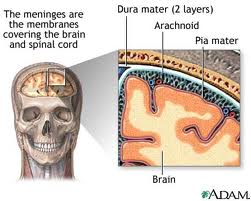
©1997–2009, A.D.A.M., Inc.
(A service of the U. S. National Library of Medicine
and the National Institutes of Health)
2. The dura mater and the pia mater, per Liebermann's revised analysis (Libermann 1905, 177–8). In his later article, he postulates that sometime before the copy in the twelfth-century Textus Roffensis (which contains the only version of this text remaining to us), scribal omission left out an extension stroke, and that the word should actually read hionne, cognate to Suio-gothic hinna and Old Danish hinnæ, which both mean "any species of membrane," (Liebermann 1905, 177–8; Rubin 1995, 19–25). The advantage of this interpretation is that is accounts for the feminine article sio. The disadvantage is that it assumes that the rupture of a bone (rigid material) and a membrane (flexible material) can be described by the same verb. Liebermann's later interpretation has nonetheless achieved general acceptance—it appears, for example, in Attenborough's edition; the Thesaurus of Old English; as Hirnhaut in Eckhardt's German translation (which is itself dedicated to Liebermann); and as membrane in the most recent English translation, that of Patrick Wormald (Attenborough 1922, 9, 178; Kay et al. 2005, s.v.; Eckhardt 1958, 25; Wormald 2005, s.v.).8 The types of arguments I brought against this reading in Beginnings had already been more thoroughly presented by Stanley Rubin, who points out that
[t]he dura mater and pia mater are two of the three membranes which lie inside the cranial vault in intimate association with each other and with the brain itself. It is significant that Liebermann shows no awareness of the existence of the third membrane, the arachnoid mater, which lies between the other two. This lack of recognition of anatomical features must seriously flaw his case. For if it is to be proposed that a sufficiently detailed knowledge of anatomical structures existed to identify individually the dura mater and pia mater, then it is hard to understand the lack of awareness of the presence of the middle membrane, the arachnoid mater. . . [Furthermore,] it is almost inconceivable that an individual with an injury severe enough to piece or rupture the meningeal membranes could have survived at this time. It is always possible in an exceptional case, but impossible to envisage survivors in sufficient numbers to justify legislation. (Rubin 1995, 21–2).9
3. The scalp and the skull, which is the interpretation favored in Beginnings. This reading was loosely based on Salic laws, which "distinguish three types of blow to the head: one which causes blood to flow, one which lays bare the skull, and one which fractures the skull" (Oliver 2002, 102; Eckhardt 1955, 62–5). Using a model based on Alfred §70.1, in which hyd (skin) is tobrocen (broken), I took "the uterre hion as the skin surrounding the skull, and the innere as the skull itself," which gives the following (mis)translation:
36. If the outer hion [?=covering of the skull] becomes broken, let him pay with 10 shillings.
36.1. If both [?outer covering and skull] should be [broken], let him pay with 20 shillings (Oliver 2002, 36).
Stanley Rubin had already arrived at the same conclusion (although his article was unknown to me at the time of publication of Beginnings): namely, that the uterre hion indicates an injury to the scalp, and the innere to the underlying bone(s) (Rubin 1995, 24).
§8. There are, however, linguistic reasons not to use Alfred's hyd tobrocen as a template for tearing of non-bony matter (that is, membranes as opposed to skull) in Æthelberht. The terminology is slightly different: Æthelberht uses the simple past participle gebrocen while Alfred adds the preverb to-, whose meaning is difficult to establish, as this is the only use of any compound of -brocen used by Alfred in the personal injury section. While numerous bones are gebrocen in Æthelberht, breaking of bones in Alfred is described variously as forad, forslean or (perhaps injured, but not broken) wund. There is no evidence to demonstrate that tobrocen, for Alfred, did not have a meaning closer to "torn" than to "broken." Certainly that is the case with, for example, the Modern English idiom used when a dog bite is said to "break the skin," in which the meaning is far more closely allied to "rip" than to "fracture."
§9. The complete context of Alfred's tobrocen reads:
§70. Gif mon oþrum rib forslea binnan gehaldre hyde, geselle .x. scillinga to bote.
§70.1. Gif sio hyd sie tobrocen, 7 mon ban ofado, geselle .xv. scillinga to bote.
(Liebermann, 1903–16, I.86)
If one breaks a rib of another with the skin intact, let him pay 10 shillings
as compensation. If the skin is broken and one breaks off a bone, let him pay 15 shillings.
Here the rigid bone of the rib is forslean, while the pliant material of the skin is tobrocen. The laws of the Frisians similarly differentiate between having (con)fracta (broken) a bone and rupta (torn) a membrane—here, particularly relevantly, the dura mater (Lex Frisionum §7–8 and §24–6).
§10. The three analyses listed above are all limited by a primary focus on medieval writings roughly contemporary with the laws, a scholarly constraint that often extends to the examination of archeological remains. Take, for example, the skull on display at York Castle Museum, on loan from the Natural History Museum in London.10
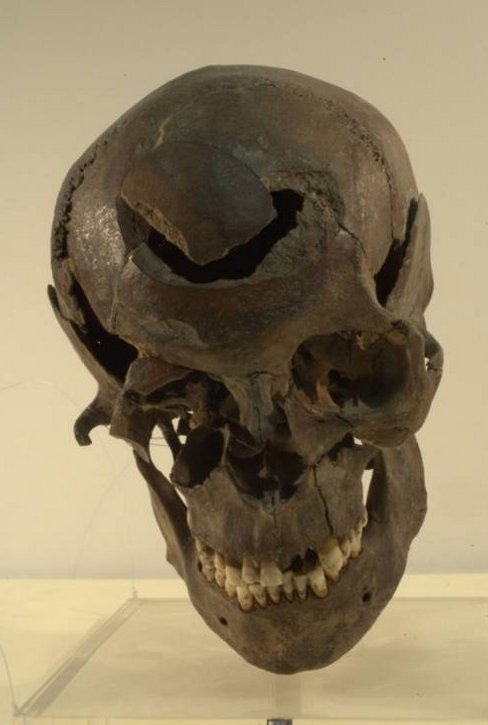
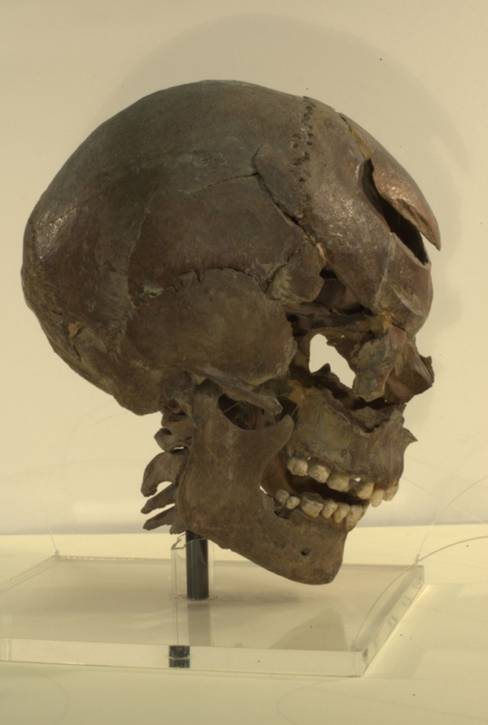
Stanwick Man
© The Natural History Museum, London
Reproduced by permission
The skull, known as "Stanwick Man," dates from early Roman Britain and it takes its name from the Stanwick Iron Age Fortifications where it was found by Sir Mortimer Wheeler. Although the wound displayed in this skull is more dramatic than those addressed in the laws (the latter cannot be mortal blows since restitution would be a full wergild for homicide rather than a percentage for injury), the Stanwick skull does provide us with a useful sectional view. The bony surface of the breach itself is wide enough to postulate a ruling that distinguishes between the outermost versus the innermost part of the skull. But Æthelberht and Alfred both use comparatives rather than superlatives here, implying external layers separated by a medial substance. This interior material would provide the anatomical distinction for the outer and inner bone layers that enclose it. The laws suggest that while the surrounding bones can be broken, the intermediate tissue is neither bone nor rigid.
The Re-Interpretation
§11. In fact, a human skull is tripartite: there is an outer bony layer (tabulum) surrounding soft tissue (the diploe), which itself rests upon an inner bony layer (tabulum). Many excavated skulls, such as that of Stanwick Man, show characteristic features of cranial holes surgically and deliberately bored for medical purposes (namely trepanation), which display "the loss of the typical layering of the skull bone at the defect margins, in particular the loss of the diploic structure. Finally, the remodeled defect margin consists of only one compact bone layer, and the internal and external tabula can no longer be distinguished" (Nerlich et al. 2003, 48). That is, while the Stanwick skull now exhibits a single bony mass, when the wound was inflicted close to a millennium ago, this same gash would have laid bare two bony plates sandwiching a spongy core. Such a distinction becomes obvious upon examining the following diagrams created by forensic anthropologists O. C. Smith, Elayne J. Pope, and Steven A. Symes, which display effects of bullet wounds to the skull.11
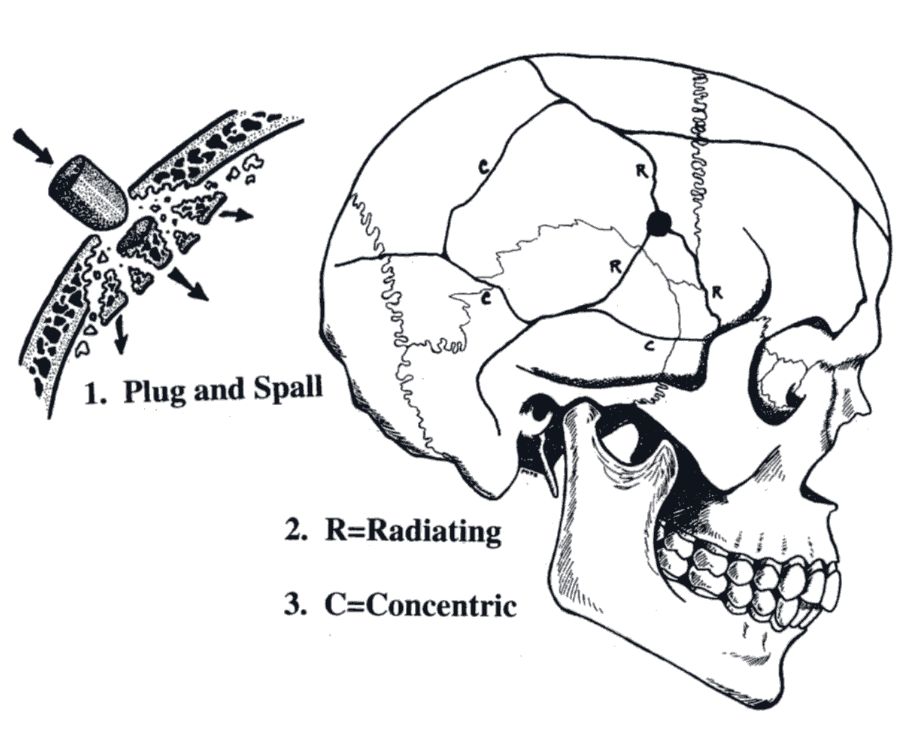
Direct Bullet Strike to Skull
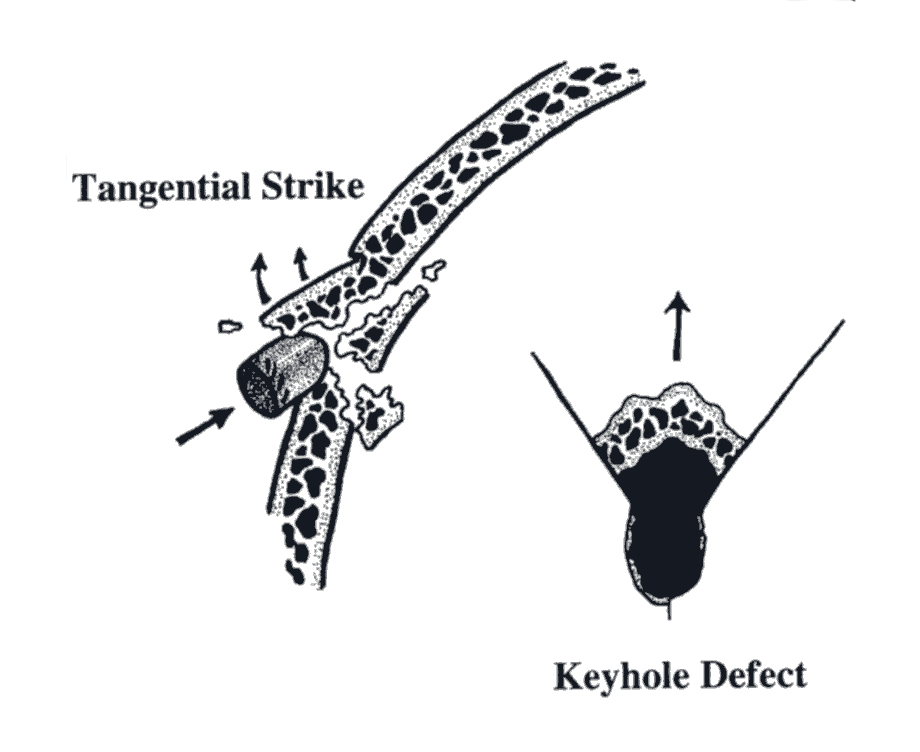
Tangential Strike to Skull
§12. These diagrams illustrate clear differences between a direct strike and a tangential strike to the skull. A direct blow from a bullet (or battle-axe) will penetrate the outer skull bone, the spongy intermediate tissue, and the inner skull bone. Considerably more spall (bony splinters) will enter the skull from the inner than from the outer bone layer. A tangential blow, on the other hand, will cause spalling outwards from the outer bone layer and inwards from the inner. Most crucially, however, a glancing—that is, superficially tangential—blow may cause the outer bone to be broken (gebrocen), without actually damaging the inner bone.
§13. Although this last instance may seem unlikely due to the physical proximity of the two tabula, an excellent case study was recently broadcast in an interview on CNN Larry King Live, Interview with Director, Cast of Bobby (the film biography of Robert Kennedy), which aired December 2, 2006. In the excerpt below King is talking with Paul Schrade, one of two men, besides RFK himself, hit by bullets fired by Kennedy's assassin Sirhan Sirhan.
SCHRADE: I was with Bob on the platform listening to his victory speech . . . And as soon as he was through, I got off and went towards the pantry, because that's where I was directed to go . . .
KING: And then what?
SCHRADE: And I turned to go, and all of a sudden I started shaking violently. I was going into shock. I didn't know what had happened. I thought it was—I thought I was being electrocuted.
KING: Did you hear a gunshot?
SCHRADE: I heard no gunshots at all. I just passed out completely. . .
KING: Where were you shot?
SCHRADE: In the head. . .
KING: A scalp wound, or. . . ?
SCHRADE: Well, no, it penetrated the first layer of skull [emphasis mine]. The doctor took out about a third of the bullet. Two thirds blew away.
KING: When did you find out that Bobby was dead?
SCHRADE: It must have been a day or two later, because I was out of it from then on.
"Out of it," but not dead. Were this his only crime, Sirhan Sirhan would have been liable for ten shillings under Æthelberht's laws, and fifteen under Alfred's. The only offense that demands an equal fine in Æthelberht is the striking off of the big toe; even today, injury to the outer skull and loss of the big toe do not seem to be vastly inequivalent injuries.12 Schrade recovered from the wound to his outer tabulum without any damage permanent enough to have warranted mention in the interview; he went on to become president of the UAW. Had his big toe been cut off, he would be limping to the present day.
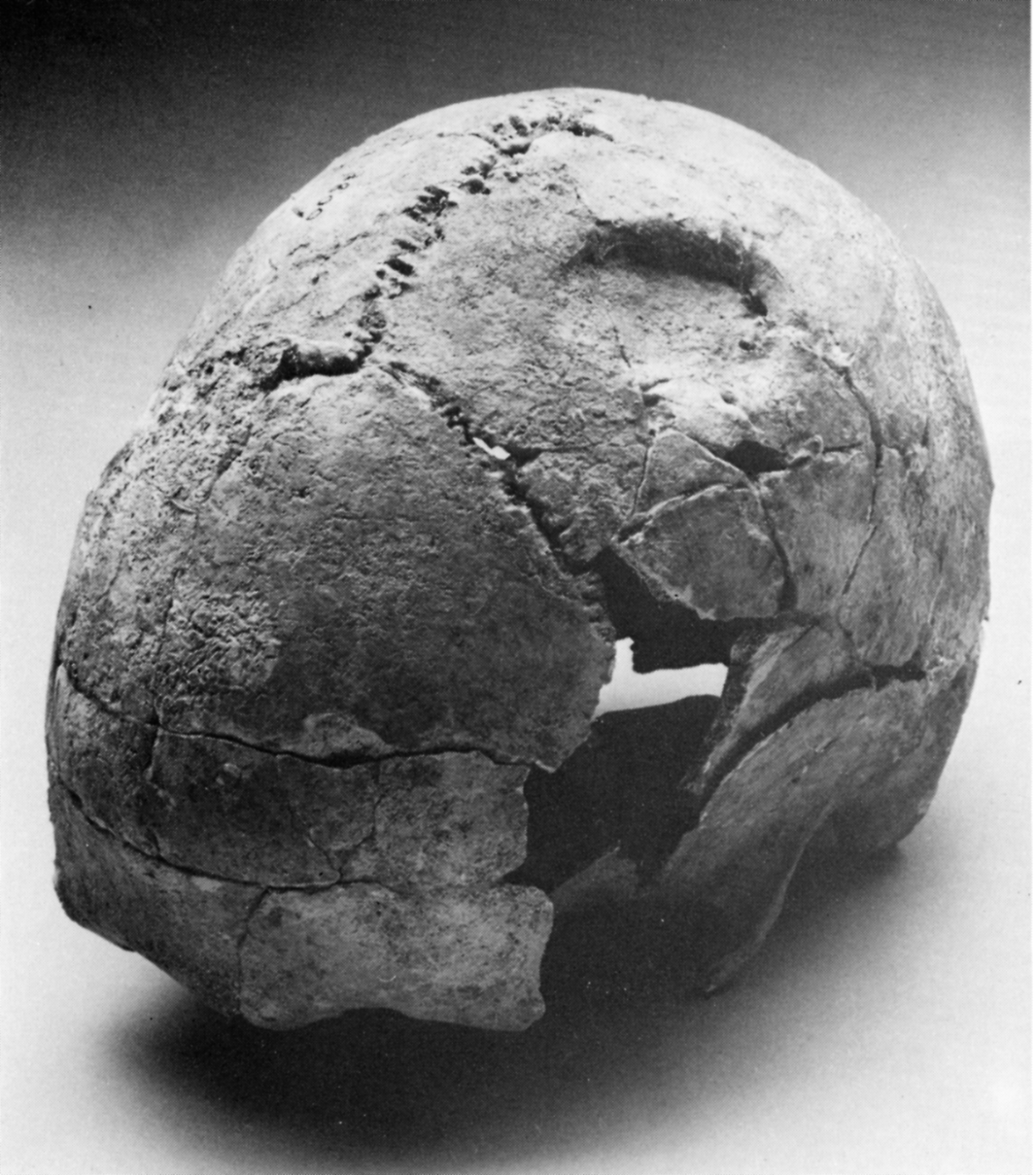
Skull from Grave 561, Weingarten (Kreis Ravensburg, Germany)
Reproduced by permission from Carestream Health Deutschland GmBH
§14. The archeological record of the early medieval period demonstrates several instances of damage to the outer tabulum that either do not touch the inner tabulum or leave there a much smaller trace. The skull of a woman from Worms has a 2 cm. diameter bone knot (presumably from a healed contusion) on the outer surface of the skull, with no mark at the corresponding spot on the inner tablulum. Grave 31 from Allach, Upper Bavaria, produced a skull with a depression 4.5 cm x 2cm on the outer tabulum that measures only 2 cm x 1 cm on the inner. A skull from the Merovingian burial field at Wies-Oppenheim has a long, oval pathological wound, almost 5.5 cm long and 2.9 cm wide that generally reaches only into the diploe and just touches the inner tablulum in the middle (Lehmann-Nitsche 1898, 11, 12–13, 23).
§15. Visual confirmation of these written reports is provided by a skull found in Germany of a man who died between the ages of twenty to forty. The depression certainly fractured the outer tabulum and seems to have also broken the inner tabulum at the most egregious point of injury. It appears, however, that the back of the wound fractured the outer layer of the skull but did not extend to the inner (Czarnetzki, et al. 1982, 45).
§16. Finally, the cure of head wounds could be aided by trepanation (drilling or gouging a hole in the skull to relieve pressure on the brain). Clearly surgeons performing this operation must have been familiar with the tri-partite division of the skull. This craft was known and practiced particularly in early Anglo-Saxon England. Of the twenty-four trepanned skulls discovered that date from the fifth to the eleventh centuries, twenty belong to the first half of this period ("ca. fifth-to-mid-eighth-century phase"), and most of them come from the southeast of England. Although the majority comes from slightly farther north, Kent (the home of Æthelberht) was the finding site for two trepanned Anglo-Saxon skulls (Roberts and McKinley 2003, 55–78).
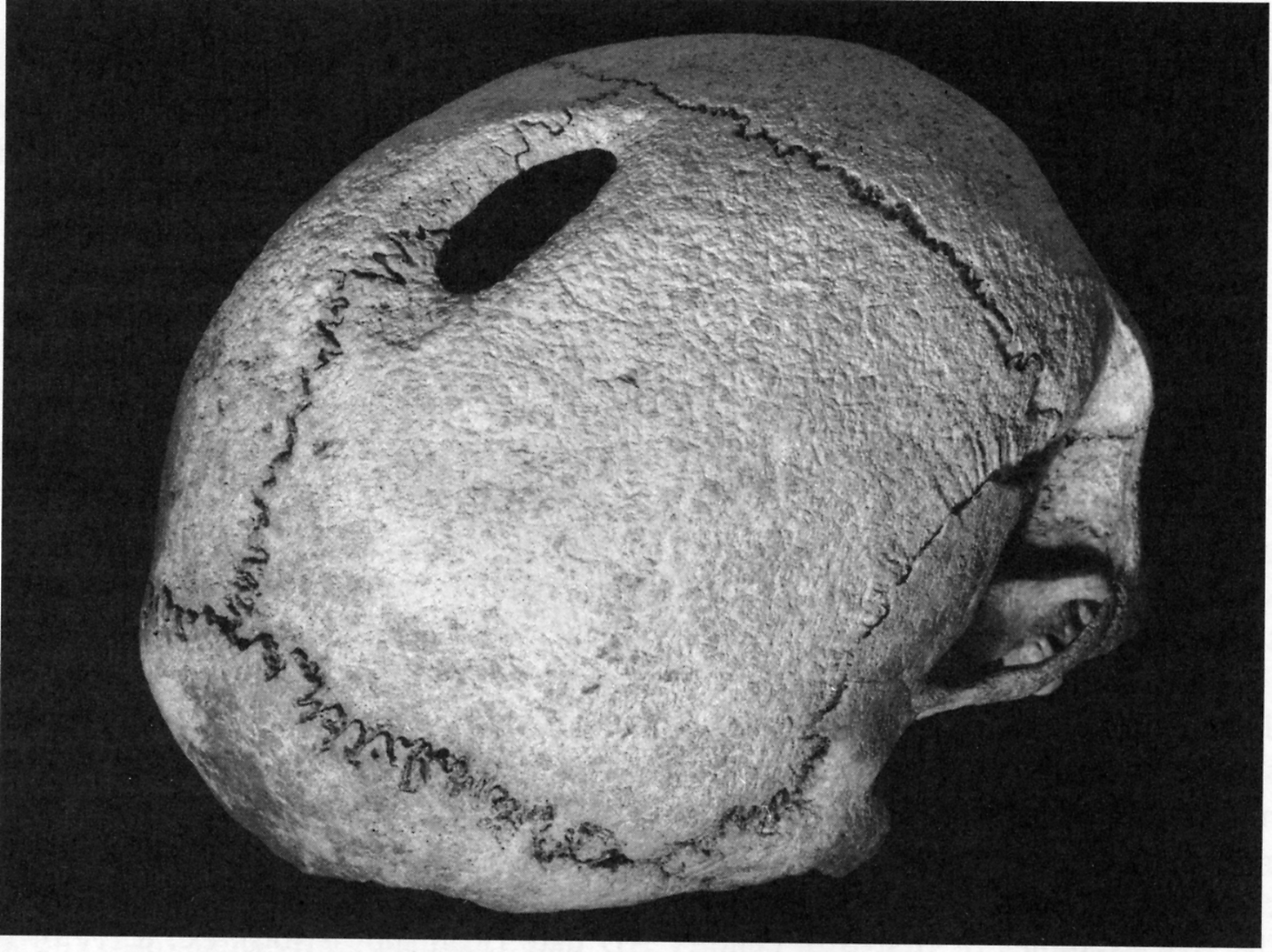
Oxborough Skull
© Wessex Archeology Ltd.
Elaine Wakefield (from a source of work by Jaqueline McKinley)
Reproduced by permission.
§17. Only eight cases of pre-mortem trepanation in Britain up to and including the Middle Ages actually demonstrate why the surgery had been performed: "In all cases the evidence was a head injury and in all except one example the head injury had healed" (Roberts and McKinley 2003, 61). The Oxborough Skull, pictured at the right, provides no certain evidence as to why the trepanation had been performed. And, like the gash in Stanwick Man's skull, the tripartite organization of the cranium is no longer apparent. However, this structure would have been obvious to the operating surgeon and to all participants or observers.
§18. Given the forensic and medical evidence adduced, I would thus retranslate the hion clauses in Æthelberht as follows:
36. If the outer layer [tabulum] of the skull becomes broken, let him pay with 10 shillings.
36.1. If both [outer and inner tabula] should be [broken], let him pay with 20 shillings.
This squares perfectly with the inner and outer bones of the head-wound described in Alfred §40.
Liebermann nods
§19. In his 1858 edition, Reinhold Schmid translates Æthelberht §36 as "Wenn die äussere (Schädelplatte) gebrochen wird. . ." (If the outer (skull-plate) is broken. . .) (Schmid 1858, 7). In Alfred §44 (Liebermann's §40) he renders gif þa ban beoð butu þyrel as "wenn beide Knochenplatten [bone-plates] durch sind. . . ," and in Alfred §44.1 (Liebermann's §41) he translates þæt uterre ban as "die äussere Kopfplatte" (the outer head-plate) (Schmid 1858, 99). It certainly seems as if Schmid must have been referring to the tabula of the skull here. Unfortunately, he provides no further elaboration in his notes. Later scholars, lacking Schmid's detailed anatomical knowledge, discarded his translation because they were unable to interpret it correctly. Liebermann thus dismisses Schmid's translation of Knochenplatten "bony plates" as unsubstantiated, although it now appears that this is the correct interpretation.
§20. Other than in the work of Schmid, the specific use of ban (bone) in Alfred's clause has been inexplicably overlooked or explained away by previous commentators. In Gesetze, Liebermann goes so far as to say that "[v]ielleicht war Abt's hioñ verlesen als ban. . . Konnte Af die dura mater 'Knochen' nennen und meinte er wie Abt Hirnhaute'?" ("Perhaps Abt's hioñ was misread as ban. . . Could Af have named the dura mater 'bone', and did he mean, like Abt, cranial membrane?") (Liebermann 1903–16, III.61). Such a misreading is, however, extremely unlikely, as shown by the respective forms from the Textus Roffensis in the following clauses:

From Æthelberht §36
Textus Roffensis fol. 2r 9
By permission of the Dean and Chapter of Rochester (2010)


From Alfred §§40 and 41
Textus Roffensis fol. 22v 13, 15
By permission of the Dean and Chapter of Rochester (2010)
The scribe would have had to make at least three, if not four, errors in the transcription of a four-letter word: the vertical of the h becomes the lower curve on the b; the o is misread as an a; the intermediate i is ignored altogether; and so is the extension stroke, if it ever existed. In short, an unlikely scenario. Rather than allow Alfred's explicit heafodwund ban to illuminate the hapax hion in Æthelberht, Liebermann bases his interpretation of Alfred on his own emendation and medically unsupportable interpretation of hionne.
Conclusion
§21. In conclusion, this is a paper with three morals:
1. The people who probably knew most about the importance of Æthelberht's (or any other early medieval) laws were the compilers themselves. If they imply (by using the terminology gebrocen, uterre, butu, and—in the case of Alfred—ban) that the skull has two bones, we must first demonstrate that this is not the case before we amend the text or meaning in search of easier alternatives.13
2. The above holds particularly true of all personal injury tariffs. Whereas a modern patient such as Schrade is rushed to the hospital, Stanwick Man's skull was literally hung out to dry. Details of anatomy were far more likely to have intruded into the normal existence of medieval man than into our own sheltered lives.
3. Medieval studies is by its nature interdisciplinary. But we must be careful not to draw artificial boundaries at the edges of our field of study. The human body at the time of Æthelberht was more like the human body of today than a bone buried at the time of Æthelberht is like a bone in a living body. The wider the scope of our investigations, particularly in a chronological sense, the more likely we are to come to a better understanding of Anglo-Saxon law and the world in which it was created.
Notes
1. I would like to thank those who read and commented on earlier versions of this paper: Calvert Watkins, Jane Roberts, Jim McIlwain, Stuart Green, Stefan Jurasinski, Andrew Rabin, Paul Edward Dutton, and my students Greg Molchan and Candice Scott. [Back]
2. The manuscript is written continuously, with no breakdown into clauses. The numbering used in this paper follows Oliver (2002), which provides a new numeration based on syntactic clues such as stipulative subjunctives and referential pronouns. Following an older system of numeration, Felix Liebermann assigns these paragraphs as §§36 and 37 (given in square brackets above) (Liebermann 1903–16, I.5). [Back]
3. Thorpe also discusses other possible parallels, none of which, however, solve the gender difficulty. [Back]
4. The only two Germanic territories that do not have a ruling on the head or skull are the Saxons and the Thüringens, both of whom have fairly abbreviated personal injury tariffs. [Back]
5. The text is taken from the H recension: the Textus Roffensis, which contains the only surviving copy of Æthelberht's laws. [Back]
6. Oliver (2006) demonstrates some interesting parallels between the first part of Alfred's personal injury tariffs and those contained in Frisian law, which I intend to investigate further. Interestingly, the double-layered skull is the only significant point of contact between Æthelberht and Alfred. [Back]
7. "Kentish or Mercian law were not introduced to Wessex nor themselves reformed. They were complimented by imitation, the effect being heightened by their inclusion in a legislative tradition said to have extended what God gave Moses" (Wormald 1999, 284). [Back]
8. F. L. Attenborough translates the first clause: "If the outer covering of the skull is broken. . ." and the second as "If both are broken. . .". Although this translation may lead one to believe he is on (what I consider to be) the right track here, a footnote to this clause cites Liebermann's contention that butu refers to the dura mater and pia mater (Attenborough 1922, 9, 178). [Back]
9. Note that the arachnoid, although one of the three cranial meninges, is not called a mater. For the origin of these terms, see Strohmaier 1970, 201–17. [Back]
10. Picture used by permission of the Natural History Museum, London. I am very grateful to Katie Anderson for her patient assistance in arranging for the photograph of the skull and the rights to use it. [Back]
11. Diagrams used with permission from Pearson Education, Inc, a division of Prentice Hall. Images taken from Smith, et al. 2003, 141–2. [Back]
12. Alfred is left out of consideration, as his laws offer an bewilderingly inconsistent list (in terms of physiological value) that is difficult to take too seriously since the same fine is assigned, for example, to striking off the arm below the elbow and striking off the 'shooting finger' or forefinger. Fifteen shilling fines are due for (in order) an outer head wound; knocked-out canine tooth; slit cheek; arm cut off below elbow; forefinger off; second (not big!) toe off; piercing into scrotum; cut from shoulder-bone; cut from rib. See Liebermann 1903–16, I.78–89. [Back]
13. Elsewhere I have argued for a return to Schmid's analysis of Æthelberht's term cearwund. Despite the justly deserved prominence of Liebermann's work, we need to give Schmid's interpretations the consideration they seem to warrant. See Oliver 2008, 319–42. [Back]
Works Cited
Attenborough, F. L. 1922. The laws of the earliest English kings. Cambridge: Cambridge University Press. [Back]
Buck, C.D. 1949. A dictionary of selected synonyms in the principal Indo-European languages. Chicago: University of Chicago Press. [Back]
Czarnetzki, A., C. Uhlig, and R. Wolf. 1982. Menschen des Frühen Mittelalters im Spiegel der Anthropologie und Medizin. Stuttgart: Württembergisches Landesmuseum. [Back]
Eckhardt, K. A. 1955. Die Gesetze des Merowingerreiches 481–714, I: Pactus Legis Salicae, Recensiones Merovingicae. Göttingen: Musterschmidt-Verlag. [Back]
———. 1958. Leges Anglo-Saxonum 601–925. Göttingen: Musterschmidt-Verlag. [Back]
Eckhardt, K. A., and A. Eckhardt, A., eds. and trans. 1982. Lex Frisionum. MGH Fontes Iuris Germanici Antiqui XII. Hannover: Hahn. [Back]
Kay, C.J., L. Grundy, and J. Roberts, eds. 2005. Thesaurus of Old English. http://libra.englang.arts.gla.ac.uk/oethesaurus/ [Back]
Lehmann-Nitsche, R. 1898. Beiträge zur prähistorischen Chirugie nach Funden aus Deutscher Vorzeit. Buenos Aires: Buchdruck, Von Fessel & Mengen. [Back]
Liebermann, Felix. 1903–16. Die Gesetze der Angelsachsen. 3 vols. Halle: M. Niemeyer. [Back]
———. 1905. Kentische hionne: Hirnhaut. Archiv für das Studium der neueren Sprachen und Literaturen 115:177–8 [Back]
Nerlich, A. G., O. Peschel, A. Zink, and F. W. Rösing. 2003. The pathology of trepanation: differential diagnosis, healing and dry bone appearance in modern cases. In Trepanation: history, discovery, theory, ed. R. Arnott et al. Lisse: Swets and Zeitlinger. [Back]
Oliver, Lisi. 2002. The beginnings of English law. Toronto: University of Toronto Press. [Back]
———. 2006. Lex Talionis in barbarian law. Journal of Indo-European Studies, 52:197–218 [Back]
———. 2008. Sick maintenance in Anglo-Saxon law. Journal of English and Germanic Philology 107:319–342. [Back]
Roberts, C. and J. McKinley. 2003. Review of trepanation in British antiquity. In Trepanation: History, Discovery, Theory, ed. R. Arnott et al. Lisse: Swets and Zeitlinger. [Back]
Rubin, Stanley. 1995. Æthelberht 36. A medico-linguistic discussion on the word hion. Nottingham Medieval Studies 39:19–25. [Back]
Schmid, Rheinhold. 1858. Die Gesetze der Angelsachsen. Leipzig: F. A. Brockhaus. [Back]
Smith, O. C., E. J. Pope, and S. A. Symes. 2003. Look until you see: identification of trauma in skeletal material. In Hard evidence: case studies in forensic anthropology, ed. D. W. Steadman. New Jersey: Prentice Hall. [Back]
Strohmaier, Gotthard, 1970. Dura Mater, Pia Mater. Die Geschichte zweier anatomischer Termini. Medizinhistorisches Journal 5:201–217. [Back]
Thatcher, Oliver J. 1907. The library of original sources. New York/London/Chicago: University Research Extension. [Back]
Thorpe, Benjamin, 1840. Ancient laws and institutes of England. London: G.E. Eyre and A. Spottiswoode. [Back]
Wormald, Patrick. 1999. The making of English law: King Alfred to the twelfth century. Malden: Blackwell Publishers. [Back]
———. 2005. The first code of English law. Canterbury: The Canterbury Commemoration Society. [Back]

